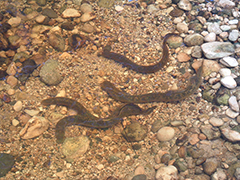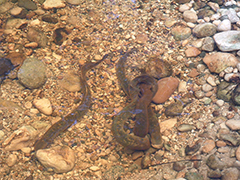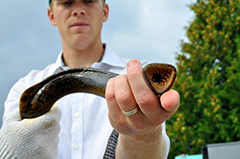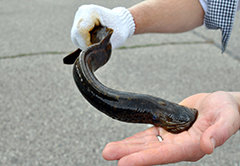

USGS scientist takes aim at Great Lakes invaders
Rising Higher: A Research Lab Built from the Ground Up - Part 2
Great Lakes Researchers Go Down Under
Rising Higher: A Research Lab Built from the Ground Up - Part 1
A Monograph on Ciscoes of the Laurentian Great Lakes and Lake Nipigon
WATCH: Acoustic Telemetry Provides In-Depth Look into Fish Behavior
Eel-Ladder Style Traps: A New Lamprey Control Tool
A Lampricide Treatment: Up-Close
Lamprey Nativeness Claims Annulled by Commission's Eshenroder
A Population at the Edge: American Eel Declining at the Extremes
Celebrating 60 Years of Successful Sea Lamprey Control, Science, and Cross-Border Collaboration!
Great Lakes Scientists Use Acoustic Telemetry to Reveal the Secret Lives of Fish
Hammond Bay Biological Station: The Nexus for Research and Restoration on the Great Lakes
Big Consequences of Small Invaders
New Sea Lamprey Estimates Suggest a Dramatically Decreased Population
Conducting Research through Cooperative Partnerships: The PERM Agreement
Living on the Edge: A Closer Look at Coastal Communities
Asian Carp: The War Isn't Over
Managing the Lake Huron Fishery
Understanding Sea Lamprey: Mapping the Genome and Identifying Pheromones

It's Getting Hot in Here!
Researchers at Michigan State University have recently discovered that a certain part of the male sea lamprey body that develops upon sexual maturation - a raised cord-like piece of tissue that runs along the lamprey's back, referred to as "rope tissue" - significantly heats up during sexual interaction with ovulating female sea lampreys. This tissue, the first of its kind discovered in a non-mammalian species, seemingly plays an important role in sea lamprey reproduction.
The spawning ritual of sea lampreys reads like a strangely fascinating science-fiction tale. The male sea lamprey initiates spawning by beckoning the female to his nest with a mating pheromone. The male then rubs the warmed rope tissue against her abdomen and, if she is agreeable, she will rub her urogenital pore against the tissue in return. The male lamprey then tightly winds his body around hers, bites onto her head, and locks onto her by tying a knot with his tail. They both writhe around releasing sex cells that will fuse together and develop in the nest. After this once-in-a-lifetime spawning event, both lamprey die.
Sea lamprey are one of the most notorious invasive species in the Great Lakes, and the Great Lakes Fishery Commission's program to control sea lamprey populations is heralded as one of the most successful invasive species control programs in the world. Much of this success is owed to the commission's commitment to research; every new piece of information gained about the sea lamprey's genetic make-up, life cycle, and behavior is a possible way to guide the development and improvement of control techniques.
Dr. Yu-Wen Chung-Davidson, a neurobiologist and one of the principal investigators on this project, observed that the rope tissue developed differentially in male and female lamprey. To investigate further, she and her colleagues inserted miniature waterproof temperature probes into the rope tissue of mature males. These lamprey were then placed separately into tanks with sexually mature male or female. Characterized as the "most dramatic observation in this study" the team found that, in the presence of an ovulating female, the temperature of the rope tissue increased by as much as 0.3°C
The research team then set out to learn how and why the rope tissue heats up prior to spawning. Examination of the tissue under magnification revealed that the tissue contains nerve bundles, oil droplets and dense mitochondria in complex fat cells. This composition appeared to be similar to a type of tissue called brown adipose tissue (BAT) found in some "thermogenic," or heat-producing animals, which allows these animals to thermoregulate, or produce warmth without physical activity. This immediately struck Dr. Chung-Davidson as unusual because sea lampreys are "ectothermic" animals, meaning they do not maintain a constant body temperature - rather, their internal temperature fluctuates with the environment.
After performing a thorough analysis of the tissue, researchers concluded that the sea lamprey rope tissue is, indeed, thermogenic. Sea lamprey, the only lamprey species with this rope tissue, are the first non-mammalian species discovered to possess thermogenic fatty tissue. The fact that the thermogenic rope tissue is only found in male sea lamprey, coupled with the finding that it selectively heats up in the presence of an ovulating female sea lamprey, suggests that the origin of this tissue may have been driven by sexual selection rather than thermoregulation like the more common mammalian thermogenic tissue (e.g. BAT).
Future research into the rope tissue will likely examine the mechanics of the internal signal(s) that cause the tissue to respond to ovulating females, as well as further investigation into the specific role the heated tissue plays in spawning.
The invasive sea lamprey has been wreaking havoc on the Great Lakes since the late 1920s when they entered the lakes from the Atlantic Ocean through shipping canals. Today, the Great Lakes Fishery Commission and its partners carry out a successful control program, with populations slashed by 90% from their historic highs. However, control is costly and eradication is impossible with current methods. The sea lamprey control program relies on exploiting potential weaknesses in the sea lamprey's life-cycle to better control this noxious predator. Innovative research like that into self-heating rope tissue, helps improve sea lamprey confront and protects the $7 billion Great Lakes fishery.

Sea lampreys build nests out of rocks in stream beds and then spawn on these nests. PHOTOS: H. DAWSON, USGS


Male sea lamprey develop the defined ridge along
their back, known as rope tissue, once they are sexually mature.
PHOTOS: A. MIEHLS, USGS/GLFC




